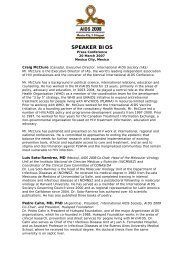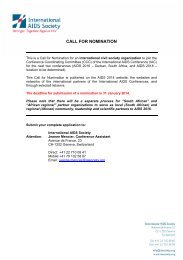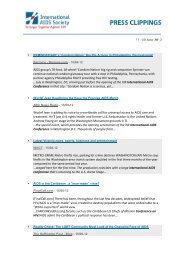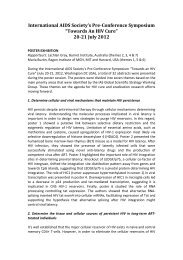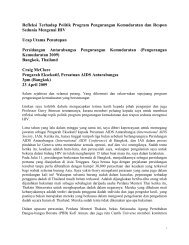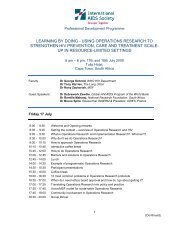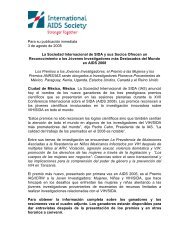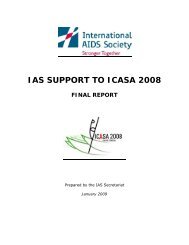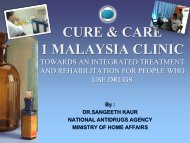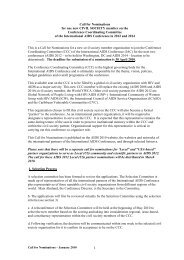Advocacy in Action - International AIDS Society
Advocacy in Action - International AIDS Society
Advocacy in Action - International AIDS Society
You also want an ePaper? Increase the reach of your titles
YUMPU automatically turns print PDFs into web optimized ePapers that Google loves.
Handout 1<br />
Case Study 1: Inclusion of sexual health education <strong>in</strong><br />
military tra<strong>in</strong><strong>in</strong>g curriculum, Mongolia<br />
What was the problem?<br />
New recruits to the armed forces, especially those from the countryside, have low knowledge<br />
of STIs and HIV/<strong>AIDS</strong>. Therefore the rate of STIs is very high (10%, <strong>in</strong> a recent survey).<br />
Who decided to advocate to address the problem?<br />
Mongol Vision, an NGO established <strong>in</strong> 1998 to implement activities on reproductive health and<br />
HIV/<strong>AIDS</strong>/STI prevention and control. Mongol Vision concentrates its activities especially<br />
among men, <strong>in</strong>clud<strong>in</strong>g officers and soldiers of the armed forces of Mongolia. The work was led<br />
by the Mongol Vision public health policy steer<strong>in</strong>g committee, which <strong>in</strong>cluded the Deputy<br />
Commander of armed forces headquarters.<br />
What was the advocacy objective?<br />
To ga<strong>in</strong> support from the high-level authorities of the armed forces to <strong>in</strong>crease STI/HIV/<strong>AIDS</strong><br />
awareness and reproductive health for military staff/soldiers.<br />
Who did you advocate to?<br />
High-level authorities and officials of the M<strong>in</strong>istry of Defence and headquarters of the armed<br />
forces.<br />
What methods did you use?<br />
• Sent letters to M<strong>in</strong>istry of Defence and headquarters of the armed forces.<br />
• Held official and unofficial meet<strong>in</strong>gs with high-level officials.<br />
• Developed a project <strong>in</strong> co-operation with high-level officials.<br />
• Ran a workshop for high-level officials.<br />
• Command<strong>in</strong>g officers and military unit doctors presented a report on the current STI situation.<br />
Handout 1 Guidel<strong>in</strong>es for writ<strong>in</strong>g an advocacy case study<br />
What difficulties did you face?<br />
F<strong>in</strong>ancial difficulties – otherwise we implemented our project successfully. It is comparatively<br />
easy to work with<strong>in</strong> the military system.<br />
How did you overcome any difficulties?<br />
We developed a small-scale project and ga<strong>in</strong>ed fund<strong>in</strong>g from the UNDP. Small payments were<br />
given to military educators as <strong>in</strong>centives.<br />
What were the results of your advocacy?<br />
• Sexual health is now <strong>in</strong>cluded <strong>in</strong> the official education curriculum for military staff.<br />
• Increased awareness of high-level officers.<br />
• Increased support from the M<strong>in</strong>istry of Defence.<br />
• Our activities are now be<strong>in</strong>g broadened.<br />
What did you learn from do<strong>in</strong>g this advocacy?<br />
• It is important to <strong>in</strong>volve high-level authorities <strong>in</strong> the activities<br />
• It is important to submit regular reports on activities and outcomes.<br />
Reference: Ms Solongo Bekhbat, Mongol Vision public health organisation.<br />
23




